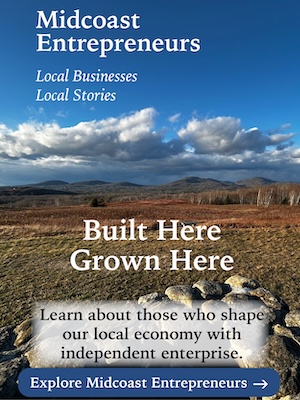By Mimi Edmunds
“A thriving success” is how Coastal Maine Botanical Gardens President Gretchen Ostherr described the Gardens in her recent presentation to West Bay Rotary. Tucked in along the Sheepscot River and its tidal tributary the Back River, the Gardens encompass a winding mile of waterfront shoreline footage that allows spectacular views, boat tours, and kayaking.
Called A People’s Garden, the Gardens were incorporated in 1992 by a small group of enthusiasts. And with the help of Harvard and a supportive community in Booth Bay, it opened to the public in 2007, encompassing 325 acres, more than 19 cultivated, and almost three miles of trails, boasting the largest botanical garden in New England by size and visits. It is the third most visited institution in Maine, after Acadia National Park and L.L. Bean, and the largest cultural institution in the state with more guests than the Portland Museum of Art or the Children’s Museum. Now with 130 employees and over 220 volunteers operating under a $12 million annual budget, the Gardens manage to welcome up to 340,000 guests annually, including 9,000 member households.
Most Botanical Gardens in this country have impressive endowments and are in, or near, a major metropolitan area. CMBG is unique for having neither, and instead operates through grants, donations, and admission fees. Further, it exists in one of the most unlikely places, an hour and a half from a major urban center, in a woodland area of stone and water by the sea.
The mission of CMBG is simple: To inspire meaningful connections between people and nature, and promote plant conservation through horticulture, education, and research. Ostherr laid out a rich set of strategic aspirations for CMBG, from expert design, sustainable horticulture and plant diversity, welcoming accessibility, deepening all people’s connection to the natural world, inspiring action on climate change, participation with communities impacted by inequity, being a diverse and inclusive workplace, a collaborator in community partnerships, and giving back to the earth more that the Gardens consume. Above all, Ostherr said CMBG seeks to inspire, serve, and provide an “exceptional guest experience.”
That experience includes 15 different named gardens and exhibit spaces, including:
- Alfond Children’s Garden, a popular interactive favorite based on children’s books
- Lerner Garden of the Five Senses
- Giles Rhododendron and Perennial Garden
- Great Lawn
- Haney Hillside Garden, with its transitions from wild to cultivated spaces
- Vayo Meditation Garden
Perhaps the most popular Art In The Gardens exhibit features enormous wooden Trolls, or “The Guardians of the Seeds,” who are meant to protect the earth, the trees, and the plants. Brought to Maine by the Danish artist Thomas Dembo, it is the biggest installation of trolls in the country and includes all five Trolls. There is even a Troll Doctor to maintain the sculptures for the next five years.
One of the most exciting projects in CMBG is a Commission with the Indigo Arts Alliance called “Deconstructing the Boundaries.” It is a three-year project centering on Black, Brown, and Indigenous relationships with the land. Now in its third year, 2023 highlighted “The Future of Land and Food Resilience”; 2024 was “The Land Fights Back”; and in 2025, the Commission’s focus is “Tending to Communities,” calling for public art through the lens of artists, scholars, historians, and cultural practitioners to create art that reflects the responsibility of life, love, and identity among communities. One example, just opened in July, is a multi-sensory project called “Look After Your Heart” by Arisa White in the Reiser Woodland Garden. It features a mirror poem titled “Revolution Is Ritual” inlaid in the Gardens pathway, and speaks to belonging, safety, rootedness, compassion, and love. Here, at the push of a button, you also experience the calming tones of a cello and beautiful vocals singing the lines, “You are here. You are safe. You are loved. You belong.”
In sum, the programs of the Gardens embrace horticulture and the land for every age and demographic to experience in a myriad of ways. It’s how the Gardens continue to have a deep and wide impact on tourism and the economy, education and the communities, conservation and the climate, and ultimately the health and well-being of both people and the planet.
As for the future, Ostherr replied, “We keep exceeding our goals, and we need to think big. So currently we are in the middle of an $82 capital campaign that will fund a new Horticulture and a Plant Science Center, a glass house of gardens, a Conservatory, and Discovery Center.”
The success of the Gardens is reflected in the generosity of its many options for free visitation and its educational efforts and impact at every level—adult, senior, youth, children, disabled, and the underserved. The Gardens are free for all Maine residents on certain calendar days; for all Boothbay neighbors, Lincoln County Residents, the Military, kids 17 and under every Wednesday in July and August; for people on snap/EBT, WIC, Medicaid, or MaineCare, or for those who simply can’t afford the admission price; 1 out of 3 field trips by Title One schools are also free. In 2024 alone, 27,000 visitors enjoyed free admission. FMI: www.MaineGardens.org.
About West Bay Rotary
West Bay Rotary is dedicated to supporting local nonprofits through service, collaboration, and philanthropy. To learn more about its initiatives and how you can get involved, visit www.WestBayRotaryOfMaine.org or come to a weekly meeting, every Thursday at 7:30 a.m. in the Community Room at the First Congregational Church in Camden. All are welcome.
 Coastal Maine Botanical Gardens President Gretchen Ostherr presents an overview of New England’s largest botanical garden at West Bay Rotary’s weekly meeting in July.
Coastal Maine Botanical Gardens President Gretchen Ostherr presents an overview of New England’s largest botanical garden at West Bay Rotary’s weekly meeting in July. Standing watch are one of the Trolls from the "Guardians Of The Seed" exhibit at Coastal Maine Botanical Gardens in Boothbay.(Photo courtesy of CMBG.)
Standing watch are one of the Trolls from the "Guardians Of The Seed" exhibit at Coastal Maine Botanical Gardens in Boothbay.(Photo courtesy of CMBG.) The Lerner Garden is one of 15 named gardens at CMBG in Boothbay. (Photo courtesy of CMBG.)
The Lerner Garden is one of 15 named gardens at CMBG in Boothbay. (Photo courtesy of CMBG.) To learn more about its initiatives and how you can get involved, visit www.WestBayRotaryOfMaine.org or come to a weekly meeting, every Thursday at 7:30 a.m. in the Community Room at the First Congregational Church in Camden. All are welcome.
To learn more about its initiatives and how you can get involved, visit www.WestBayRotaryOfMaine.org or come to a weekly meeting, every Thursday at 7:30 a.m. in the Community Room at the First Congregational Church in Camden. All are welcome.


























